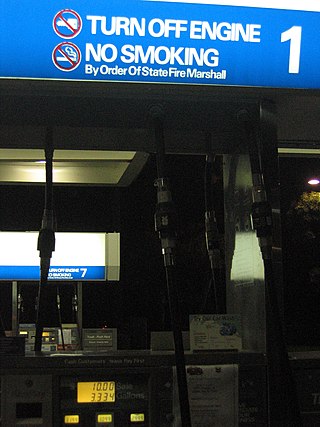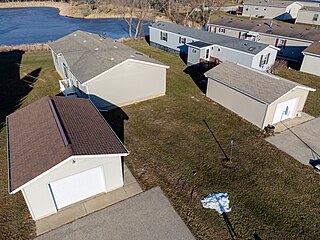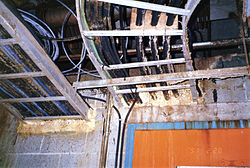
In urban planning, zoning is a method in which a municipality or other tier of government divides land into "zones", each of which has a set of regulations for new development that differs from other zones. Zones may be defined for a single use, they may combine several compatible activities by use, or in the case of form-based zoning, the differing regulations may govern the density, size and shape of allowed buildings whatever their use. The planning rules for each zone determine whether planning permission for a given development may be granted. Zoning may specify a variety of outright and conditional uses of land. It may indicate the size and dimensions of lots that land may be subdivided into, or the form and scale of buildings. These guidelines are set in order to guide urban growth and development.

A fire marshal, in the United States and Canada, is often a member of a state, provincial or territorial government, but may be part of a building department or a separate department altogether. Fire marshals' duties vary but usually include fire code enforcement or investigating fires for origin and cause. Fire marshals may be sworn law enforcement officers and are often experienced firefighters. In larger cities with substantially developed fire departments the local fire departments are sometimes delegated some of the duties of the fire marshal.

The National Electrical Code (NEC), or NFPA 70, is a regionally adoptable standard for the safe installation of electrical wiring and equipment in the United States. It is part of the National Fire Code series published by the National Fire Protection Association (NFPA), a private trade association. Despite the use of the term "national", it is not a Federal law. It is typically adopted by states and municipalities in an effort to standardize their enforcement of safe electrical practices. In some cases, the NEC is amended, altered and may even be rejected in lieu of regional regulations as voted on by local governing bodies.

A mobile home is a prefabricated structure, built in a factory on a permanently attached chassis before being transported to site. Used as permanent homes, or for holiday or temporary accommodation, they are often left permanently or semi-permanently in one place, but can be moved, and may be required to move from time to time for legal reasons.
A model building code is a building code that is developed and maintained by a standards organization independent of the jurisdiction responsible for enacting the building code. A local government can choose to adopt a model building code as its own. This saves local governments the expense and trouble of developing their own codes. Many smaller governments lack the expertise to do so.
The National Building Code of Canada is the model building code of Canada. It is issued by the National Research Council of Canada. As a model code, it has no legal status until it is adopted by a jurisdiction that regulates construction.
The publication Life Safety Code, known as NFPA 101, is a consensus standard widely adopted in the United States. It is administered, trademarked, copyrighted, and published by the National Fire Protection Association and, like many NFPA documents, is systematically revised on a three-year cycle.
The International Code Council (ICC) is a nonprofit standards organization that creates the International Building Code (IBC), a model building code, as well as the International Residential Code (IRC), and other model codes. The IBC has been adopted for use as a base code standard by most jurisdictions in the United States.

The Eurocodes are the ten European standards specifying how structural design should be conducted within the European Union (EU). These were developed by the European Committee for Standardization upon the request of the European Commission.
A Form-Based Code (FBC) is a means of regulating land development to achieve a specific urban form. Form-Based Codes foster predictable built results and a high-quality public realm by using physical form as the organizing principle, with less focus on land use, through municipal regulations. An FBC is a regulation, not a mere guideline, adopted into city, town, or county law and offers a powerful alternative to conventional zoning regulation.

The California Public Utilities Commission is a regulatory agency that regulates privately owned public utilities in the state of California, including electric power, telecommunications, natural gas and water companies. In addition, the CPUC regulates common carriers, including household goods movers, limousines, rideshare services, self-driving cars, and rail crossing safety. The CPUC has headquarters in the Civic Center district of San Francisco, and field offices in Los Angeles and Sacramento.
Building regulations in the United Kingdom are statutory instruments or statutory regulations that seek to ensure that the policies set out in the relevant legislation are carried out. Building regulations approval is required for most building work in the UK. Building regulations that apply across England and Wales are set out in the Building Act 1984 while those that apply across Scotland are set out in the Building (Scotland) Act 2003. The Act in England and Wales permits detailed regulations to be made by the Secretary of State. The regulations made under the Act have been periodically updated, rewritten or consolidated, with the latest and current version being the Building Regulations 2010. The UK Government is responsible for the relevant legislation and administration in England, the Welsh Government is the responsible body in Wales, the Scottish Government is responsible for the issue in Scotland, and the Northern Ireland Executive has responsibility within its jurisdiction. There are very similar Building Regulations in the Republic of Ireland. The Building Regulations 2010 have recently been updated by the Building Safety Act 2022.
Building officials of developed countries are generally the jurisdictional administrator of building and construction codes, engineering calculation supervision, permits, facilities management, and accepted construction procedures.

Deutsches Institut für Bautechnik (DIBt) is a technical authority in the construction sector. The Institute carries out its activities on the basis of an agreement concluded between the Federation and the German federal states (Länder). Its most important task is the approval of non-regulated construction products and construction techniques. The Institute is based in Berlin.
Performance-Based Building Design is an approach to the design of any complexity of building, from single-detached homes up to and including high-rise apartments and office buildings. A building constructed in this way is required to meet certain measurable or predictable performance requirements, such as energy efficiency or seismic load, without a specific prescribed method by which to attain those requirements. This is in contrast to traditional prescribed building codes, which mandate specific construction practises, such as stud size and distance between studs in wooden frame construction. Such an approach provides the freedom to develop tools and methods to evaluate the entire life cycle of the building process, from the business dealings, to procurement, through construction and the evaluation of results.
The International Green Construction Code (IGCC) is a set of guidelines that aim to improve the sustainability and environmental performance of buildings during their design, construction, and operation. It was introduced by the International Code Council (ICC), a non-profit organization that provides building safety and fire prevention codes for the United States and other countries. It is a model code designed to be mandatory where it is implemented.

United States building energy codes are a subset of building codes that set minimum requirements for energy-efficient design and construction for new and renovated buildings. The intent of these energy codes is to moderate and reduce energy use and emissions throughout the lifetime of a building. Energy code provisions may include various aspects of building design and construction, such as: HVAC systems, building envelope, electrical, and lighting systems. There are building energy codes for both commercial and residential buildings. However, just as the United States does not have a national building code, it also does not have a national building energy code; rather, state, and local governments choose to adopt—and potentially revise—national model energy codes and standards. Consequently, building energy codes, and building codes in general, vary between states and jurisdictions.
The California Green Building Standards Code is Part 11 of the California Building Standards Code and is the first statewide "green" building code in the US.
The California Building Standards Code is the building code for California, and Title 24 of the California Code of Regulations (CCR). It is maintained by the California Building Standards Commission which is granted the authority to oversee processes related to the California building codes by California Building Standards Law. The California building codes under Title 24 are established based on several criteria: standards adopted by states based on national model codes, national model codes adapted to meet California conditions, and standards passed by the California legislature that address concerns specific to California.
The Uniform Mechanical Code (UMC) is a model code developed by the International Association of Plumbing and Mechanical Officials (IAPMO) to govern the installation, inspection and maintenance of HVAC and refrigeration systems. It is designated as an American National Standard.








